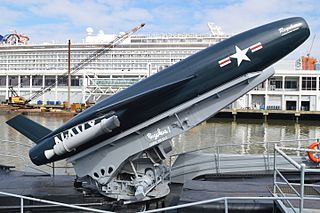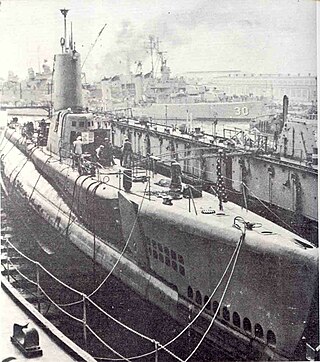
The SSM-N-8A Regulus or the Regulus I was a United States Navy-developed ship-and-submarine-launched, nuclear-capable turbojet-powered second generation cruise missile, deployed from 1955 to 1964. Its development was an outgrowth of U.S. Navy tests conducted with the German V-1 missile at Naval Air Station Point Mugu in California. Its barrel-shaped fuselage resembled that of numerous fighter aircraft designs of the era, but without a cockpit. Test articles of the Regulus were equipped with landing gear and could take off and land like an airplane. When the missiles were deployed they were launched from a rail launcher, and equipped with a pair of Aerojet JATO bottles on the aft end of the fuselage.

USS Barbero (SS/SSA/SSG-317) was a Balao-class submarine of the United States Navy, named for a family of fishes commonly called surgeon fish.

USS Argonaut (SS-475) was a Tench-class submarine operated by the United States Navy (USN). Constructed at Portsmouth Navy Yard during the second half of 1944, Argonaut was commissioned into the USN in 1945 and operated against Japan during the final year of World War II, although her only contact with the Japanese was when she sank a junk in August. During the 1950s, the submarine was modified for greater underwater endurance, and to guide the Regulus I missile. From 1963 to 1965, Argonaut operated in the Mediterranean Sea.

USS Halibut (SSGN-587), a unique nuclear-powered guided missile submarine-turned-special operations platform, later redesignated as an attack submarine SSN-587, was the second ship of the United States Navy to be named after the halibut.

USS Grayback (SS/SSG/APSS/LPSS-574), the lead ship of her class of submarine, was the second ship of the United States Navy to be named for the grayback.

USS Tang (SS/AGSS-563), the lead ship of her class was the second ship of the United States Navy to be named for the tang.

The Balao class was a design of United States Navy submarine used during World War II, and with 120 boats completed, the largest class of submarines in the United States Navy. An improvement on the earlier Gato class, the boats had slight internal differences. The most significant improvement was the use of thicker, higher yield strength steel in the pressure hull skins and frames, which increased their test depth to 400 feet (120 m). Tang actually achieved a depth of 612 ft (187 m) during a test dive, and exceeded that test depth when taking on water in the forward torpedo room while evading a destroyer.

USS Medregal (SS-480/AGSS-480), a Tench-class submarine, was the only ship of the United States Navy to be named for the medregal, a streamlined, fast-swimming, bluish-colored fish of the jack family which abounds in waters of the West Indies and in the Atlantic as far north as the Carolinas.

USS Bashaw (SS/SSK/AGSS-241), a Gato-class submarine, was the first ship of the United States Navy to be named for the bashaw. Between 10 March 1944 and 29 April 1945, she completed six war patrols in the Celebes, Philippine, and South China Seas during World War II. Bashaw sank three Japanese merchant vessels totaling 19,269 gross register tons as well as several small craft. She later served in the Vietnam War.

USS Bream (SS/SSK/AGSS-243), a Gato-class submarine, was the first ship of the United States Navy to be named for the bream. She served during World War II, and her war operations extended from 1 June 1944 to 15 June 1945. During this period she completed six war patrols operating in the Java Sea, Celebes Sea, Sulu Sea, South China Sea, and Gulf of Siam. She sank two Japanese merchant ships totaling 6,934 gross register tons. In addition, Bream shared with the submarines USS Ray (SS-271) and USS Guitarro (SS-363) the destruction of a 6,806-gross register ton passenger-cargo ship. On 23 October 1944, while patrolling off western Luzon, Bream made a daring surface attack on a Japanese naval force, damaging the heavy cruiser Aoba.

USS Devilfish (SS/AGSS-292), a Balao-class submarine, was a ship of the United States Navy named for the devil fish.

USS Manta (SS/ESS/AGSS-299), a Balao-class submarine, was the first submarine and second ship of the United States Navy to be named for the manta.

USS Becuna (SS/AGSS-319), a Balao-class submarine in commission from 1944 to 1969, was a submarine of the United States Navy named for the becuna, a pike-like fish of Europe. During World War II, she conducted five war patrols between August 23, 1944 and July 27, 1945, operating in the Philippine Islands, South China Sea, and Java Sea. She is credited with sinking two Japanese tankers totaling 3,888 gross register tons.

USS Besugo, a Balao-class submarine, was a ship of the United States Navy in commission from 1944 to 1958. She was named for the besugo.

USS Bumper (SS-333), a Balao-class submarine, was a ship of the United States Navy named for the bumper, a small fish of the North and South Atlantic Ocean.

USS Carp (SS/AGSS/IXSS-338), a Balao-class submarine, was the second ship of the United States Navy to be named for the carp.

USS Cusk (SS/SSG/AGSS-348), a Balao-class submarine of the United States Navy named for the cusk, a large food fish related to the cod.

The second USS Menhaden (SS-377) was United States Navy Balao-class submarine. Launched in 1944, she operated out of Pearl Harbor until 1946, then continued in use out of various ports in the Pacific until the 1970s. She was then decommissioned and re-fitted as a remotely controlled, unmanned acoustic test vehicle known as the "Yellow Submarine", until she was scrapped in 1988.

USS Sea Cat (SS/AGSS-399), a Balao-class submarine, was a ship of the United States Navy named for a shortened form of sea catfish, a marine fish of little food value found off the southeastern coast of the United States commissioned on 16 May 1944, with Commander Rob Roy McGregor in command. During World War II Sea Cat operated within the Pacific theatre, conducting four war patrols in wolf packs accounting for up to 17400 tons in the form of three cargo ships and an enemy vessel. Sea Cat earned three battle stars for her World War II service.

The Regulus missile submarines were a group of submarines operated by the United States Navy capable of carrying the Regulus cruise missile. Between 1959 and 1964, a total of five boats were used to undertake the first submarine-based nuclear deterrent patrols by the United States. Regulus submarines were used for this task until 1964, when sufficient ballistic missile submarines carrying the Polaris ballistic missile became available.





















